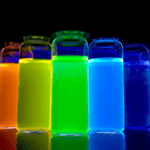Chemists at the University of Saskatchewan are looking to lower the cost of solar panels by advancing an alternative to today’s silicon-based technology.
Made from sheets of ultra-pure silicon, commercial solar panels require large amounts of energy to produce. A less costly alternative is perovskites, tiny crystals made of methylammonium lead iodide or other substances that can convert light into electricity with nearly the same efficiency.
Perovskite crystals are not only easier to produce than ultra-pure silicon, but they can also be mixed with liquids to create a “solar ink” that could be coated or printed on surfaces using existing technology. This approach that would drastically reduce the cost of solar cell manufacturing.
But there’s a catch: perovskite crystals are less stable than silicon ones. Even a little bit of moisture can disrupt their crystal structure, destroying their light-harvesting properties.
Professor Tim Kelly and PhD candidate Soumya Kundu specialize in materials for solar power, and are looking at ways to stabilize perovskites so that they could be used in next-generation photovoltaics.
“A solar cell is a bit like a sandwich,” says Kelly. “There are many layers, each with its own function. The one we’re looking at in this research is called the hole-transport layer, which enables the electrical current to flow from the perovskites into the circuit.”
Because the hole-transport layer sits right next to the perovskite layer, Kelly and the team decided to see if they could design one that would protect the crystals from degradation while also fulfilling its important role in conducting electrical charge.
In a study recently published in the Canadian Journal of Chemistry, the pair reported how they built their hole-transport layers out of electrically conductive polymers known as poly(3-alkoxythiophenes). By adding different side chains to the polymer backbone, they could control the degree to which the material attracted water (hydrophilicity) or repelled water (hydrophobicity).
“We went all the way from strongly water-attracting side chains to perfluorinated ones that have a similar structure to Teflon, and so are strongly water repelling,” says Kelly. “What we found was that with the most hydrophobic materials, the perovskites last more than 100 times longer than with the standard polymers.”
The finding was exciting, but unfortunately it came at a cost: the more hydrophobic polymers suffered in terms of their primary function, i.e., extracting electrical charge. The solar cells produced using them may have lasted longer, but they were only one-fifth as efficient at converting light into electricity.
Still, the findings pointed the way forward. Kelly and Kundu later found more success by blending two different polymers, one a poly(3-alkylthiophene) and the other a poly(methyl methacrylate), also known as plexiglass.
“You could actually hold that material under a full stream of running water with no loss in performance,” says Kelly. “So this was one critical step along the way, and by applying what we learned, we created something that, hopefully, will make solar power even more accessible in the future.”
Read the paper: Hydrophobic polythiophene hole-transport layers to address the moisture-induced decomposition problem of perovskite solar cells in the Canadian Journal of Chemistry.




